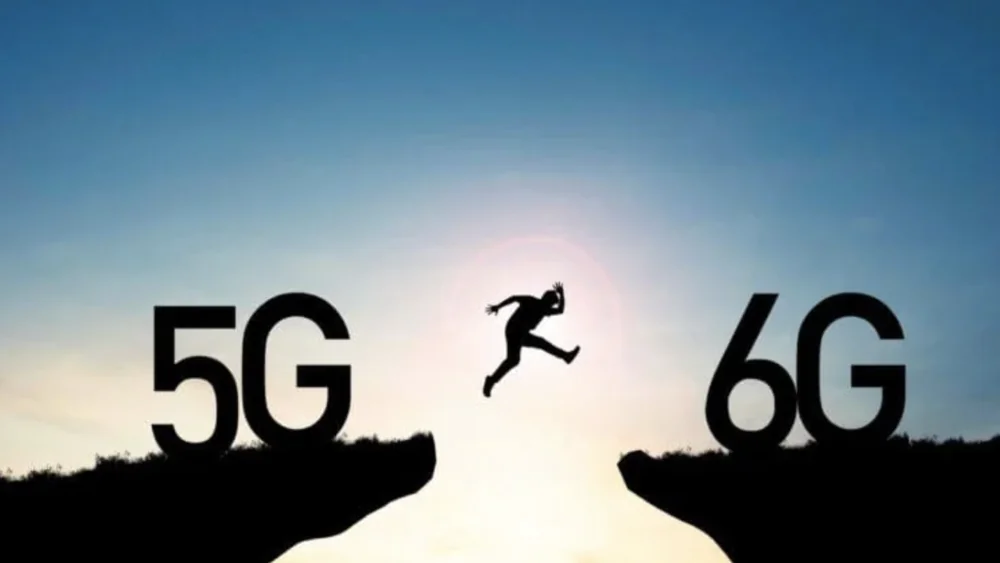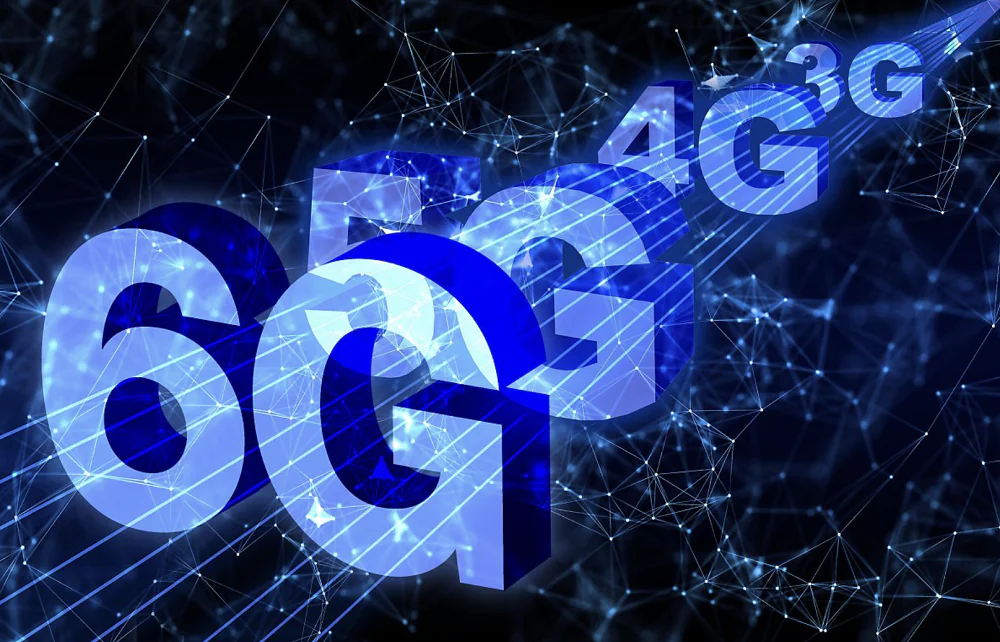© ROOT-NATION.com - Use of content is permitted with a backlink.
Although 5G wireless networks are still in the early stages of deployment, wireless companies are already looking ahead and thinking about the next mobile network. It will be called 6G.
Technically, 6G doesn’t exist yet. But experts imagine that it is the next stage of wireless technology that will use new approaches, such as edge computing and artificial intelligence, to create a completely new type of Internet. 6G developers are also exploring the potential of terahertz waves, which are sub-millimetre-sized microscopic radio waves that straddle the line between microwaves and infrared. They are needed to significantly reduce latency and increase data transfer speeds up to 1Tbps. This is a thousand times faster than the highest Wi-Fi speed.

Of course, at this early stage, all of this is still purely theoretical. But the growing interest in this topic has led to government investment in research and partnerships between universities and telecoms companies. So let’s take a deeper dive into the world of 6G and imagine what the future holds.
Read also: Does Elon Musk’s TruthGPT have a future?
What is 6G?
Of course, 6G is the sixth generation of wireless technology. The 6G network follows on from today’s 4G and 5G networks, using higher frequency bands and flexible cloud network technology to deliver record-breaking data speeds and microsecond latency.

According to articles by telecoms experts, 6G takes technology that was originally designed for mobile phones and applies it to a much wider range of uses, including transport, healthcare, agriculture and smart home networks. The result is a seamless connection between the internet and everyday life.
What are the benefits of 6G?
The main advantage of 6G will be its ability to facilitate instant communication in smartphones, computers, wearables, robotics, etc. Experts say that technologies such as terahertz waves and edge computing will enable the widespread introduction of wearable smart devices, metaverse tools, automated infrastructure and other things we don’t even know or dream about yet.

In any case, it is still just an idea. The 6G network will require a lot of work to implement. It will also require the involvement of key stakeholders, including the public, who may not yet be quite ready for radical technological change.
When will 6G become available to consumers?
6G is expected to become available around 2030. This is the estimate of most experts, given that new wireless standards appear approximately every decade. But nothing is set in stone – even the term “6G” itself may lose popularity at some point and be replaced by something else.
The reason why some experts have become interested in 6G technology is that there are big changes happening in Internet technology in general. Consumers are using more devices and consuming Internet data at record speeds, incorporating Wi-Fi into almost every aspect of their daily lives. And tech companies are rushing to compete with traditional broadband providers, hoping to meet the growing demand with reliable and flexible cellular networks.
4G→5G→6G – the gradual evolution of wireless technologies
| Network | Speeds | Supported devices |
|---|---|---|
| 4G | approx. 41.9 Mbps | Mobile phones, tablets, access points |
| 5G | 40–1100 Mbps | Mobile phones, tablets, access points, public infrastructure, automated cars |
| 6G | Up to 1Tbps (1,000,000 Mbps) | Automated cars, cellular surfaces, Wi-Fi implants |
The cellular phone internet technology we have today is largely based on 4G LTE technology, a wireless communications standard that was first launched in late 2009. 4G LTE has radically improved the data transfer speeds on our mobile devices, particularly smartphones, allowing users to enjoy, for example, HD video streaming and play modern mobile video games.
AT&T, T-Mobile, and other mobile service providers launched 5G in 2018 and 2019 in the United States. They are now building 5G cellular networks across the country. Verizon and T-Mobile have also launched 5G home internet, which uses the same 5G networks to give you a home Wi-Fi experience similar to fibre or cable internet. 5G is steadily moving across the planet and becoming available to users in different countries. Unfortunately, in Ukraine, 5G networks are still only at the development stage and are not available to users.

Current 5G speeds range from 40 to 1,100 Mbps, depending on the type of 5G network in use. Using technologies such as millimetre wave spectrum and beamforming, experts estimate that 5G could reach maximum speeds of up to 10,000 Mbps. Whether or not 5G reaches this limit, companies using wireless technology are now moving beyond simply serving our phones and have plans to use 5G for other applications in industry, business, healthcare and remote work.
Perhaps when we reach 10,000 Mbps (10 Gbps), wireless companies will have already launched 6G. Obviously, 6G will mean much more than just internet speed.
Read also: The best tools based on artificial intelligence
What will 6G look like?
It’s hard to say what 6G will look like – after all, it doesn’t exist yet. But in media interviews and research papers, wireless companies and academics describe 6G as a fully integrated internet system that enables instant communication between consumers, devices, vehicles and the environment.
We now have the beginnings of the Internet of Things (IoT), which connects smartphones and smart home devices. In time, we will be able to achieve a comprehensive Internet of everything within our reach. But this will depend on future developments such as 6G (or whatever it will be called) and how it works.

Here is a summary of what experts say about 6G.
Speed 1Tbps
Some experts believe that 6G networks will eventually allow for a maximum data transfer rate of 1Tbps on Internet devices.
That’s a thousand times faster than 1Gbps (the highest speed available today on most home internet networks), and it’s 100 times faster than 10Gbps (the hypothetical maximum speed of 5G). So, yes, these are rosy assumptions, and we are still a long way from achieving these speeds.
In essence, however, researchers predict that 6G will emphasise extremely high bandwidth and reliability. With 6G, Internet access will be instantaneous and constant, and for many of us, it will become an integral part of our daily lives.
Terahertz waves
In 2019, the Federal Communications Commission (FCC) opened the gates to the potential future of 6G by allowing companies to start experimenting with what are called “terahertz waves”, or as they are also called “submillimetre waves”. These are radio waves that are in the range of 95 GHz to 3 THz (terahertz).
Terahertz waves have a higher frequency than millimetre waves, which are now perceived as a kind of Holy Grail that will solve the problems of network congestion and bandwidth limitations. Extended versions of 6G depend on millimetre wave bands to transmit huge amounts of data at ultra-high speeds with minimal response times, which will theoretically make it possible to develop things like automated cars and remote surgical operations.
The catch is that millimetre waves only work over short distances, requiring line-of-sight between the transmitter and the user. And terahertz waves have an even shorter range. But if they can be properly harnessed with some new networking approaches, it will open up even more possibilities for doing complex things in a 6G wireless network.
Read also: 7 coolest ways to use ChatGPT
Artificial intelligence and edge computing
Automated cars and drones, remote-controlled factories, and other uses of artificial intelligence (AI) are generating a lot of discussion as 5G grows. The advent of 6G is expected to make this even more relevant, and experts believe that artificial intelligence will be needed to coordinate and run smoothly.
For example, Razvan-Andrej Stojka and Giuseppe Abreu, researchers at Jacobs University in Bremen, Germany, said that 6G could rely on “collaborative artificial intelligence” to help self-driving cars communicate with each other, manage pedestrians and vehicles, and determine the best routes to take around the city.
It’s part of a new trend called edge computing, which is moving network management away from centralised clouds and towards more localised devices, making things run smoother by reducing the time it takes to answer questions.
Another 6G expert, Roberto Saracco of the European Institute of Innovation and Technology, suggested that things like artificial intelligence and edge computing could help devices become network antennas themselves, keeping your Wi-Fi connection in a seamless, ever-changing connection between users and their devices.
Immersive technologies
Virtual reality is expected to play a big role in 5G. But this is only the beginning. In the 6G era, some experts envision even more exciting technologies such as cellular surfaces, connected implants, and “wireless brain-computer interfaces” (!!!).
Walid Saad, a renowned professor at Virginia Tech and the lead author of the official 6G paper for July 2019, predicts that smartphones will eventually be replaced by smart devices, headsets, and implants that can receive direct sensory data from humans and reproduce their feelings.
Japanese mobile company NTT DoCoMo predicts a complete merger of physical life and cyberspace: “In cyberspace, it will become possible to support human thoughts and actions in real time with the help of wearable devices and micro-devices installed on the human body.”
What is a 6G base station?
A 6G base station is a wireless communication station used to receive and transmit cellular signals. Although there are no base stations for 6G yet, 4G LTE and 5G networks use cell towers and “small cells” – small transmitters installed on street corners and utility poles – to transmit internet and cellular data to our phones and other wireless devices.

What do experts say about 6G?
According to VMware’s Kaniz Mahdi, 6G research is still at a very early stage. It will probably take several more years before the latest technologies, such as millimetre waves, reach their full potential. A newly formed group called the Open Grid Alliance is also looking to “rebuild” the Internet as a whole so that it can better support major applications such as control systems for automated cars and factories.
“We’re looking to evolve the Internet itself,” Mahdi said, noting that VMware is part of the alliance.
As 6G research continues and the technology evolves, many more challenges lie ahead. 6G is expected to provide the communications infrastructure for billions of devices. These devices will require constant power, and most of them will be battery-powered. All of this increased energy production and consumption poses a potential threat to the environment if there are no plans to reduce the carbon footprint of 6G technology.

How we provide sustainable power to all these devices is a big challenge, especially given the need to achieve sustainability in modern technology and power consumption. This needs to be taken into account in the design and development of 6G, so as not to be left with a problem that will need to be solved later!
6G means big changes for the internet and for life itself
Remember: at the moment, 6G is just a bunch of ideas. You don’t need to run out and buy a Tesla or Samsung unmanned brain scanner just yet.
But there is a lot of interest in 6G networks and technologies from companies and governments around the world. There are many of them, including trade groups such as the Next G Alliance and initiatives piloted by Chinese companies such as ZTE and China Unicom. South Korea is also planning to introduce the latest 6G network technologies. And this points to the high expectations of many experts about how the Internet may evolve in the coming years and its potential impact on the way we communicate, work and live.
So, keep your eyes open. Perhaps in about ten years’ time, we will all be able to communicate in Zoom with a new pair of 6G retinal implants.
Read also:

